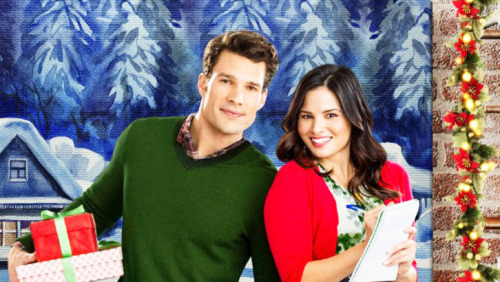As the holiday season approaches, Netflix’s collection of bad, low budget holiday movies is growing almost as fast as my holiday belly. You, dear reader, need only watch one: Love Actually, by far the prize jewel in the holiday movie crown. You can skip the literal hundreds of others that collage the screen upon opening Netflix, unless you’re in the mood for major cheese, a veritable cornucopia of Christmas trees, dramatic dialogue peppered with exclamation points, and flannel. If you do decide to click on “The Christmas ________” [insert pretty much anything here: Kiss, Crush, Wedding, Date, Crisis], here is how it will go:
“The Christmas ________”
We open on our female protagonist—probably named Noel or Joy—inevitably doing something that both involves snow, and reminds her how alone she is. Chances are, she’s walking through the snowy streets of Manhattan, forlornly noticing couple after couple holding hands, and looking at window displays of glamorous women. Though she is undeniably beautiful, she will never be as glamorous or lovable as those Bloomingdale’s mannequins, *sigh*.
Noel returns to her office job after this brief period of unexplained wandering. Her office is full of young women who are all friends. There is also one crazy boss. The boss drops an unfathomably large and heavy stack of papers (seriously, who even prints that much anymore?) on Noel’s desk and inexplicably asks her to “go through them” before tomorrow, which sounds hopelessly impossible, even without knowing what “go through them” could mean. The protagonist sighs mournfully but gets to work, as her coworker friends chide her about “working too hard” and “needing to loosen up” and “let her hair down.” She does none of these things! She’s hard working and unlovable, after all, as is evident by her glasses, a clear sign of a woman for whom romantic involvement is just out of reach.
She stays late at the office, and it’s been long dark when she finally flips through the last paper on her desk, looking disheveled and exhausted. All of her friends have gone out, but she’s spent the day working too long and hard for that now, plus, again, she wears glasses, so it would all be too much. As she leaves the office she gets a phone call from her mother, to whom she complains sorrowfully about her singledom. Her mother offers a meager anecdote about Christmas spirit that will ultimately be very meaningful and important to the sentimentality of the plot.
Then, the impossible intervenes.
This takes the form of something strange and magical. Perhaps Noel gets stuck in the elevator just as a rogue bolt of lightning strikes her office building. Perhaps her kind heart spurs her to do something generous for a Salvation Army bell-ringing Santa or a stray elf whom she assumes is just working in a department store but turns out to be—wait for it—an actual elf! Perhaps she makes a wish and throws a coin into a fountain or takes a spontaneous carriage ride through the park or meets a mysterious stranger or gets dressed up to go out with her friends once and for all, totally unrecognizable without her glasses and slight frown.
The impossible intervenes, and our protagonist finds this bout of magic odd and confusing, and perhaps even mildly irritating (she hates fun, after all), but carries on back to her small but cozy New York apartment and pretends all is normal. And yet, at this pivotal moment, we know her life will never be the same.
Enter: the love interest. The next day, Noel meets her man, though she of course doesn’t know it yet, as she assumes no man will ever love her. He looks exactly like a Ken Doll, with perfectly coiffed hair and an almost plastically strapping physique. He wears a warm, huggable sweater and Noel literally bumps into him as she is picking up coffee for her crazy boss. He is kind and gracious and she’s overwhelmingly apologetic for being so darn klutzy. Later that day, the two inexplicably run into each other again! What a coincidence! This likely happens while they are both shopping for Christmas trees or casually perusing a local bookshop. The man—probably named Chris—is one of two alternate characters: either unbelievably perfect or very irritating. If he is the former, he’s a banker or lawyer or doctor or doesn’t work but is still very wealthy. He volunteers at a soup kitchen or tutors underprivileged children in his spare time. He holds doors for Noel and asks her out for coffee, romantically taking off her glasses as she looks at him, shocked that he finds her—her—so stunning. If, instead, he’s irritating, he and Noel are forced together and engage in argumentative banter (which will start when he says something like “Christmas is dumb”) until some shared experience brings them together in an unexpected but heartwarming way. In this moment, each realizes that opposites attract, and they really love their regular repartee and would feel lost without it. Noel and Chris fall in love.
And finally, the twist. This is where the movie takes a turn toward ~holiday spirit~, and the shocking truth is revealed. Maybe Chris is actually the son of Santa Claus, or a real live elf, or was built by elves in response to Noel’s desperate holiday wish or her kind, kind heart. Perhaps Noel discovers that she is actually related to Santa, or makes some other important self-discovery. Maybe Noel and Chris are involved in some crazy scheme to save Christmas. Perhaps there’s another magical moment involving a mysterious stranger or an elf or a carriage ride in the park.
This final twist is inevitably followed by a proposal or other indicator that Noel and Chris will be in love forever. There is a dramatic full-body-contact close-up kiss, likely in a lamp-lit park as snow flurries like molting angel wing feathers around them. Santa’s sleigh flies silhouetted against the moon in the background.
The end.
Image via.
